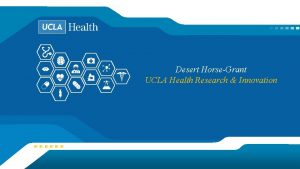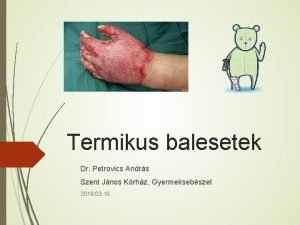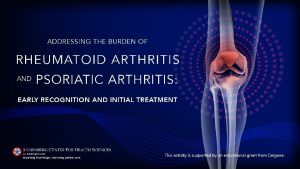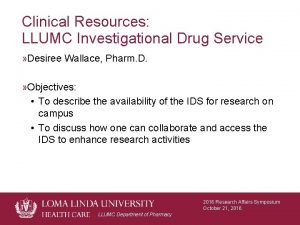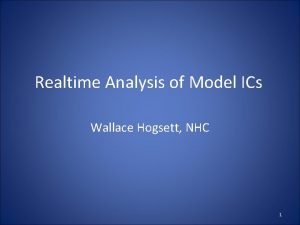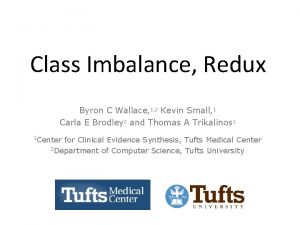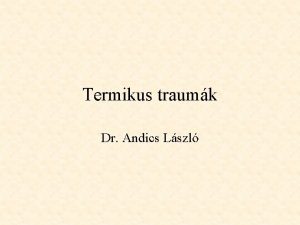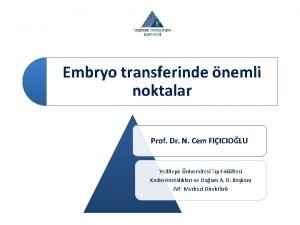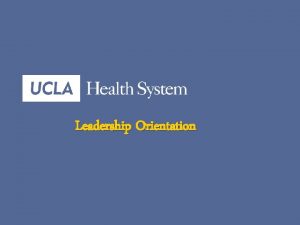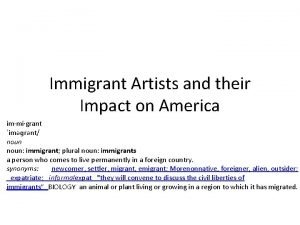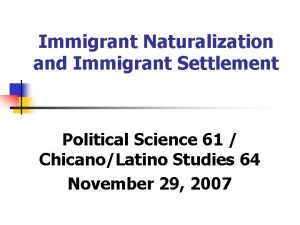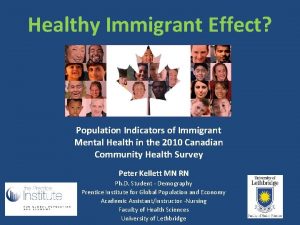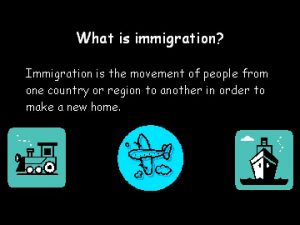Immigrant Health Steven P Wallace Ph D UCLA

















































- Slides: 49

Immigrant Health Steven P. Wallace, Ph. D. UCLA School of Public Health & UCLA Center for Health Policy Research http: //swallace. bol. ucla. edu

Outline v Who are immigrants? v What is their health status & risks? v What determinants of health vary for them? v What are community health strategies? v What are their health systems issues?

1. Demographics of immigration

Country of origin of immigrants, all ages, 2006 United States California Source: U. S. Census Bureau, 2006 Current Population Survey

Changing immigrant sources 1890 – 14. 6% born abroad, mostly W & N Europe 1930 – 11. 5% born abroad, most common Italy, Poland, Russia… Ellis Island, 1902

Immigration Reform 1965 Added Western hemisphere quota 1965 Added family reunification 1980 Refugee act 1986 IRCA – amnesty for undocumented, employer sanctions San Ysidro border crossing

Country of origin of immigrants, all ages, 2006 United States California Source: U. S. Census Bureau, 2006 Current Population Survey

Population of all Mexican Americans & only Mexican immigrants in the U. S. Source: U. S. Census Bureau, Current Population Survey 1994 -2006

Mexican-born and Mexican-American Population and Percentage of Total Population in California, 2005 Population Proportion of total Source: Estimates based on U. S. Census Bureau, Current Population Survey (CPS), March 2005.

Exhibit 3: States with more than 100, 000 Mexican immigrants, 2006 1. 2. 3. 4. 5. 6. 7. 8. 9. 10. 11. 12. 13. 14. California 4. 4 million Texas 2. 2 million Arizona 713, 000 Illinois 526, 000 Florida 317, 000 Georgia 316, 000 North Carolina 273, 000 Colorado 268, 000 New York 209, 000 Nevada 198, 000 New Jersey 130, 000 Oregon 122, 000 New Mexico 118, 000 Washington 116, 000 Source: U. S. Census Bureau, 2006 Current Population Survey

Age distribution of Mexican immigrants and others, U. S. 2006 Source: U. S. Census Bureau, 2006 Current Population Survey

Contribution of Mexicans and Mexican-Americans to Population Growth in California ages 15 to 44 and 0 to 15, 1990 -2000 Source: Estimates based on U. S. Census Bureau, 15 -percent sample 1970, 5 -percent sample 1980, 5 -percent sample 1990 and 5 -percent sample 2000.

Exhibit 8: Labor force participation of men ages 18 -64, 2006 United States California Source: U. S. Census Bureau, 2006 Current Population Survey

Why immigrant health? context Employed in segmented labor market – Especially manual & service occupations – Low incomes, benefits, difficult work Live in segregated housing – Low income housing with more structural and other problems – Concentrated in low performing schools – Experience similar shortages of public space & other public services

Mexican immigrants = 20% of the male CA labor force, but account for many workers in: (n=13, 000) (n=105, 000) (n=25, 000) (n=11, 000) (n=27, 000) (n=125, 000) (n=108, 000) (n=18, 000) (n=34, 000) (n=142, 000) Source: U. S. Census Bureau, 2006 Current Population Survey. %

“Carwasheros” Difficult work Largely undocumented Often paid less than minimum wage No benefits, insurance Living wage could easily be passed on in price Photo: LA Times March 27, 2008

Why immigrant health? Individual factors Knowledge – prior experience with health and healing systems Culture – beliefs and values related to health and healing Beliefs, rumors – about immigration status and risks

2. Immigrant health status & Risks

Life expectancy @ birth Source: Singh & Hiatt, International Journal of Epidemiology, 2006

Relative Rates, Immigrant v. Native (adjusted for age, sex, income, region, etc) Native rate=1 Source: Singh & Hiatt, International Journal of Epidemiology, 2006

Immigrant Birth Outcomes Better * Per 1000 live births Source – CDC, MMWR, December 6, 2002 http: //www. cdc. gov/mmwr/preview/mmwrhtml/mm 5148 a 3. htm

Immigrant paradox: High risk factors Low income Low education Poor working conditions Overcrowded housing

Immigrant paradox: BUT good outcomes Mortality Chronic conditions like heart disease (except diabetes) Birth outcomes

3. Determinants of Health

Mexican Immigrants have lowest levels of education Source: SSA, Inmigrantes Mexicanos y Centroamericanos en Estados Unidos, 2006 Adults 25 years and older, U. S. , http: //www. healthpolicy. ucla. edu/pubs/publication. asp? pub. ID=196

Mexican immigrants have high levels of poverty United States California Source: SSA, Inmigrantes Mexicanos y Centroamericanos en Estados Unidos, 2006 Adults 18 years and over living in poverty, U. S. And CA, 2005 http: //www. healthpolicy. ucla. edu/pubs/publication. asp? pub. ID=196

Immigrant paradox: Why? Selection effects = health/social capital – Health? (Rural Mexican women, Rubalcava, AJPH, 2008) – Education (found in all countries, exc. Puerto Rico; Feliciano, Demography, 2005) – Social Networks? – Other human capital?

Immigrant paradox: Why? Selection effects Return migration (salmon effect) – 1/3 of Mexican immigrants return w/i 10 years – Mortality is lower for Mexicans (who can return) than Cubans (who can not) – Can this explain birth outcomes? ?

Immigrant paradox: Why? Selection effects Return migration (salmon effect) Health behaviors (culture) – Lower rates of smoking, healthier diets – Stronger social networks Direct effects – helping out, share info, etc Indirect effects – buffer stress – Erodes w/acculturation Acculturative stress Changing behaviors

Immigrant paradox: Why? Selection effects Return migration (salmon effect) Health behaviors (culture) Community effects (context) – Immigrants communities have an independent protective effect – Assimilation reduces (vs. acculturation)

n. s. =married, educ, income, immigrant, English interview, neighborhood poor

4. Community health strategies Sustain healthy behaviors Improve medical infrastructure Improve social & environmental context of health Photo: http: //www. flickr. com/photos/roscoland/962051804/

Healthy Behaviors Promote good nutrition: in schools, stores, food stamps Facilitate physical activities: via sports, parks school yards Disseminate information via promotoras Sustain social networks via public space

Improve medical infrastructure Sustain/expand community clinics, school based clinics Increase bilingual, bicultural workforce Better connect workers to workers compensation system Expand preventive & elder care, screenings & treatment

Improve context for health Improve housing, building enforcement Improve workplace health & safety, Cal. OSHA, living wage and other enforcement Improve air quality in immigrant communities

Summary, immigrant paradox Better health outcomes despite many risk factors Some health advantage due to selection, other to health behaviors, other to social & community conditions To maintain health capital, community health strategies are important

5. Medical Care Issues

Mexican immigrants have the lowest levels of health insurance of all in CA in poverty Source: SSA, Inmigrantes Mexicanos y Centroamericanos en Estados Unidos, 2006 Adults 18 years and older who live in poverty, U. S. , http: //www. healthpolicy. ucla. edu/pubs/publication. asp? pub. ID=196

Mexican immigrants lack connection to health care facilities Source: California Health Interview Survey, 2003 Adults 18 or older, California

Mexican immigrants have the highest levels of no medical visits in the past two years Source- CONAPO, Migración México-Estados Unidos, Temas de salud. 2005. Adults 18 years or older, U. S. http: //www. healthpolicy. ucla. edu/pubs/publication. asp? pub. ID=154

Mexican immigrants have the lowest levels of emergency room visits Fuente- CONAPO, Migración México-Estados Unidos, Temas de salud. 2005. Adults 18 and over U. S. http: //www. healthpolicy. ucla. edu/pubs/publication. asp? pub. ID=154

Mexican immigrants have the highest use of health or dental services in Mexico Source - 2001 California Health Interview Survey Adults 18 years or over, California

Adults age 18 and over with no doctor visit past year Source: California Health Interview Survey, 2003

Adults age 18 and over with no dental visit in past year Source: California Health Interview Survey, 2003

Adults age 65 and over with no influenza immunization past year Source: California Health Interview Survey, 2003

Adults age 50 and over who have never had a colorectal exam Source: California Health Interview Survey, 2003

Women age 18 -64 with no pap smear past three years Source: California Health Interview Survey, 2003

Summary, health care Mexican and Central American immigrants are an important part of California’s population They face substantial access to care barriers It is possible to provide adequate access to care to these populations

Conclusion Immigrants are “here to stay” They face a number of special health, health behavior, and access to health care issues It is critical to address those issues to maintain a health California
 Stephen wallace ucla
Stephen wallace ucla Ucla student alexandra wallace
Ucla student alexandra wallace Definiton of dignity
Definiton of dignity Migrant hostel analysis
Migrant hostel analysis Tapestri inc
Tapestri inc Emigrant v immigrant
Emigrant v immigrant An immigrant is someone who
An immigrant is someone who Cabrini center for immigrant legal assistance
Cabrini center for immigrant legal assistance Ucla health leadership
Ucla health leadership Ucla innovation challenge
Ucla innovation challenge Wallace 9'lar kuralı
Wallace 9'lar kuralı William wallace fate
William wallace fate Foy e wallace
Foy e wallace Wallace 9-es szabály
Wallace 9-es szabály Stein w. wallace
Stein w. wallace Locke wallace marital adjustment test
Locke wallace marital adjustment test Integridad tegumentaria
Integridad tegumentaria Model siklus penelitian wallace
Model siklus penelitian wallace Angelo buono
Angelo buono Wallace weber
Wallace weber Russell wallace day
Russell wallace day Daniel wallace md
Daniel wallace md Daniel j wallace md
Daniel j wallace md Desiree wallace
Desiree wallace Foy e wallace
Foy e wallace Regula lui wallace
Regula lui wallace Aportes de wallace
Aportes de wallace Lincoln wife
Lincoln wife Wallace community college sparks campus
Wallace community college sparks campus Wallace hogsett
Wallace hogsett Professor angela wallace
Professor angela wallace Modified parkland formula
Modified parkland formula Baldwin wallace tuition
Baldwin wallace tuition Sight translation
Sight translation Byron c. wallace
Byron c. wallace Prof nthle
Prof nthle An update of wallace’s zoogeographic regions of the world
An update of wallace’s zoogeographic regions of the world Are any of abraham lincoln's descendants alive
Are any of abraham lincoln's descendants alive Wallace frança curriculo
Wallace frança curriculo George c wallace community college
George c wallace community college Krisztalloid
Krisztalloid Wallace diamond test for urobilinogen in urine
Wallace diamond test for urobilinogen in urine Wallace bolyai gerwien theorem
Wallace bolyai gerwien theorem Eumetazoa
Eumetazoa Zita wallace letter to kevin rudd
Zita wallace letter to kevin rudd Jerry m wallace
Jerry m wallace Is survival selfish by lane wallace
Is survival selfish by lane wallace Mainland se asia
Mainland se asia Bricker wallace
Bricker wallace Wallace embryo transfer catheter
Wallace embryo transfer catheter









